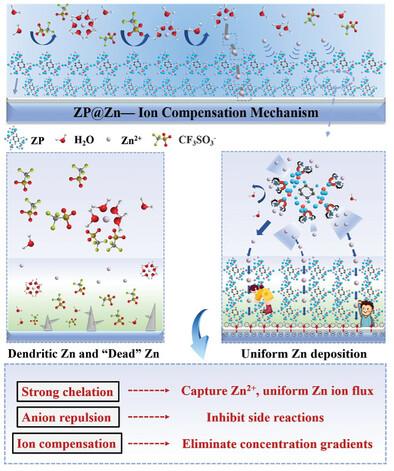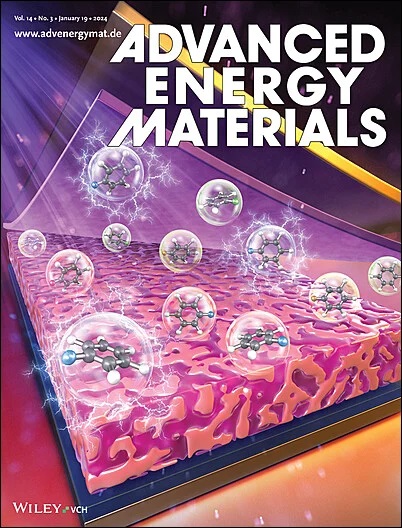富Zn2 +螯合层通过阳离子补偿和阴离子排斥促进超高速率锌阳极的生成
IF 24.4
1区 材料科学
Q1 CHEMISTRY, PHYSICAL
引用次数: 0
摘要
水锌离子电池由于其低成本、固有安全性和环境友好性,在下一代大规模储能系统中具有很大的前景。然而,锌金属阳极的可逆性受到界面浓度梯度引起的严重副反应和枝晶生长的限制。为了解决这个问题,一种富含Zn2+的植酸锌(ZP)螯合层作为人工固体电解质间相(SEI)被引入,通过离子补偿消除了这些浓度梯度。理论计算和实验结果表明,ZP层富含Zn2+离子,具有较强的螯合能力,可以捕获更多的Zn2+,使Zn2+在界面处快速、动态地补充离子,显著提高了Zn2+的输运动力学,保证了Zn2+的通量均匀。此外,PO₄基团的强螯合作用限制了Zn2 +离子的二维扩散,促进了Zn的均匀沉积。此外,ZP层排斥阴离子,限制水分子在Zn阳极表面的迁移,从根本上抑制副反应。结果表明,在1ma cm−2和1mah cm−2条件下,锌阳极的镀/剥离时间约为2400 h,平均库仑效率为99.8%。此外,组装的ZP@Zn//VO2电池在5 A g−1电流密度下,经过6000次循环后,容量保持率为87.5%。本文章由计算机程序翻译,如有差异,请以英文原文为准。

Zn2⁺-Rich Chelate Layer Facilitates Ultrahigh-Rate Zinc Anodes Via Cation Compensation and Anion Repulsion
Aqueous Zn ion batteries hold great promise for next-generation large-scale energy storage systems due to their low cost, intrinsic safety, and environmental friendliness. However, the reversibility of Zn metal anodes is limited by severe side reactions and dendritic growth, caused by interfacial concentration gradients. To address this, a Zn2+-rich zinc phytate (ZP) chelate layer is introduced as artificial solid electrolyte interphase (SEI) that eliminates these concentration gradients through ions compensation. Theoretical calculations and experimental results demonstrate that the ZP layer, rich in Zn2⁺ ions and exhibiting strong chelating ability to capture more Zn2+, enables rapid and dynamic ion replenishment at the interface, significantly improving Zn2⁺ transport kinetics and ensuring a uniform Zn2⁺ flux. Moreover, the strong chelation of PO₄ groups restricts the 2D diffusion of Zn2⁺ ions, promoting the uniform Zn deposition. Additionally, the ZP layer repels anions and restricts water molecules migration at the Zn anode surface, fundamentally suppressing side reactions. As a result, the modified Zn anode exhibits stable Zn plating/stripping for ≈2400 h at 1 mA cm−2 and 1 mAh cm−2, with an average Coulombic efficiency of 99.8%. Furthermore, the assembled ZP@Zn//VO2 cell displays 87.5% capacity retention after 6000 cycles at the current density of 5 A g−1.
求助全文
通过发布文献求助,成功后即可免费获取论文全文。
去求助
来源期刊

Advanced Energy Materials
CHEMISTRY, PHYSICAL-ENERGY & FUELS
CiteScore
41.90
自引率
4.00%
发文量
889
审稿时长
1.4 months
期刊介绍:
Established in 2011, Advanced Energy Materials is an international, interdisciplinary, English-language journal that focuses on materials used in energy harvesting, conversion, and storage. It is regarded as a top-quality journal alongside Advanced Materials, Advanced Functional Materials, and Small.
With a 2022 Impact Factor of 27.8, Advanced Energy Materials is considered a prime source for the best energy-related research. The journal covers a wide range of topics in energy-related research, including organic and inorganic photovoltaics, batteries and supercapacitors, fuel cells, hydrogen generation and storage, thermoelectrics, water splitting and photocatalysis, solar fuels and thermosolar power, magnetocalorics, and piezoelectronics.
The readership of Advanced Energy Materials includes materials scientists, chemists, physicists, and engineers in both academia and industry. The journal is indexed in various databases and collections, such as Advanced Technologies & Aerospace Database, FIZ Karlsruhe, INSPEC (IET), Science Citation Index Expanded, Technology Collection, and Web of Science, among others.
 求助内容:
求助内容: 应助结果提醒方式:
应助结果提醒方式:


